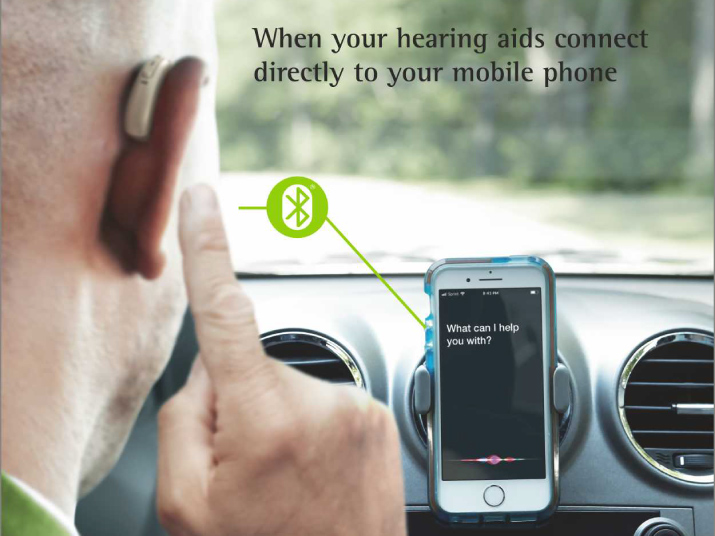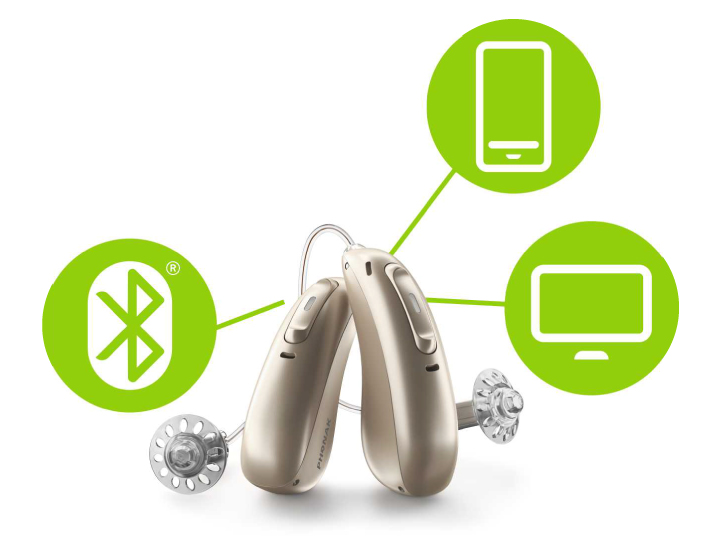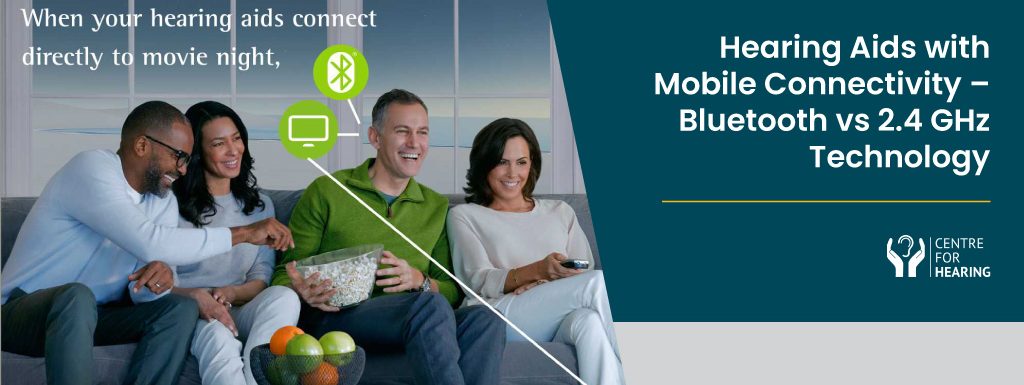Hearing aids come in different designs, technology and are packed with variable features. However, one of the most recent feature introductions in modern hearing aid technology is Bluetooth (2nd to Rechargeable technology – see our previous article on rechargeable technology in hearing aids here.
Bluetooth has opened up the possibilities of connecting hearing aids to our favourite communication devices such as mobile phones (both Android and iPhone) and TV. The quality of TV and Mobile lacked clarity until now – owing to the loss of sound from the speaker to the hearing aid microphone. These issues stand well-resolved since the introduction of 2.4 GHz and Bluetooth Technologies.
So, out of the two, which technology hearing aids with mobile connectivity is best for you? Keep reading to find out more…
Hearing Aids with Mobile Connectivity Using Bluetooth

Bluetooth technology allows us to share information with other electronic devices wirelessly. Bluetooth is commonly used in mobile phones, TVs, cars, etc., for streaming content. In other words, you can facetime or watch WhatsApp/ youtube videos without the audio streaming directly into your ears at the frequency-specific sound level necessary as per your hearing loss. Hearing aids with mobile connectivity via Bluetooth help you connect to other supporting devices, making it easier to answer and return calls.
Here are the benefits of using Bluetooth-enabled hearing aids for daily use.
- Bluetooth is widely available in many phone models – across both Android and iPhone. This has been adopted and offered ONLY by Sonova hearing aids at the moment (as of the date of publishing this article 24th December 2021) with their Phonak, Hansaton and Unitron brands. Alternatively, the technology used by all the other hearing aid companies is largely compatible only with iPhones and a few Android models from the One Plus, Samsung and Google Pixel stables. Thereby making Bluetooth easier to adopt even with cheaper phone models.
Android phones not compatible with 2.4 GHz technology from Widex, Phonak, ReSound and Starkey hearing aids require an additional accessory (or streaming device). - Arguments in favour of 2.4 GHz Technology offered at the moment by ReSound, Signia, Starkey and Widex.
- The 2.4Ghz frequency band is more robust, durable and offers better signal stability in connectivity.
- Reduced latency in receiving audio from the streaming devices such as mobile, TV, etc.
- Improved Signal to Noise Ratio (SNR) provides a better shield to background noise and clearer audio.
Other advantages of using Bluetooth hearing aids are listed below.
- Bluetooth-enabled hearing aids can personalise your listening experience – from adjusting hearing aids settings to streaming music – it can do them all.
- Hearing aids with mobile connectivity can pair with multiple devices with the help of a streamer, which also facilitates switching audio signals across the devices.
- Bluetooth-enabled hearing aids can significantly help hearing loss by magnifying sound vibrations for more precise hearing.
- These devices can also reduce external noises and prevent audio feedback.
Hearing Aids with Mobile Connectivity Using 2.4 GHz Technology

The advent of 2.4Ghz wireless connectivity has eliminated the need for intermediary devices such as streamers in hearing aids. This 2.4 GHz (which is a radio frequency) allows the hearing aids to directly connect with streaming devices, mobile phones and TV giving the user much more control over his activities.
The 2.4Ghz frequency band is globally accepted and is used by most cordless phones, video game consoles, home wireless networks, garage door openers, etc.
Moreover, the wireless signal transmission in 2.4Ghz frequency allows for long-distance communication. This capability eliminates the need for a neck-worn relay to communicate with the hearing aids.
Apart from the advantages mentioned above, the 2.4Ghz also comes with other benefits, as described below.
- The 2.4Ghz frequency band is more robust, durable and offers better signal stability in connectivity.
- Reduced latency in receiving audio from the streaming devices such as mobile, TV, etc.
- Improved Signal to Noise Ratio (SNR) provides a better shield to background noise and clearer audio.
Recent Developments in Hearing Aids with Mobile Connectivity
The Development of MFi (Made for iPhone) hearing devices has made it possible for those with hearing difficulties to have a hands-free phone and Facetime conversations on their Apple devices.
The makers of Android phones have also adopted similar technology to pair hearing aids directly with mobile phones.
These technologies help you control your hearing device and set preferences for playing ringtones, audio routing, and the ability to switch audio by the device used.
Final Thoughts: Bluetooth Vs 2.4Ghz Technology
At the moment, the decision seems to largely depend on the mobile phone model you are using – Phonak is the only easy option for most Android models, whereas iPhone users can adopt any of the 2 options.
At the Centre for hearing, our hearing care professionals can help you choose the right hearing aids with mobile connectivity for you, based on your unique needs.
We offer several products that use modern technology to overcome hearing loss. With state-of-the-art hearing care facilities, the Centre for Hearing clinics provide hearing evaluations and hearing care solutions such as Pure Tone Audiometry (PTA), basic hearing test, and other solutions such as Tympanometry Oto-Acoustic Emissions, to name a few.
We have clinics across various places in India. So if you or your loved ones face difficulty in hearing, then do not worry. Just give us a call, and we will provide the right solutions to your problems.
Learn more about How to get your free hearing aids consultation here.
Call us on +91 9811227269 for a FREE CONSULTATION!

















